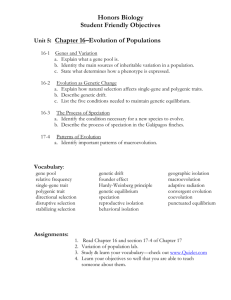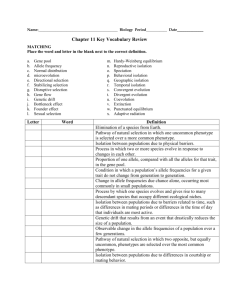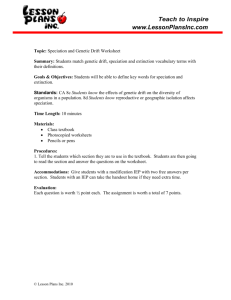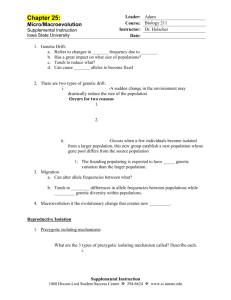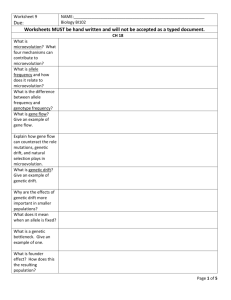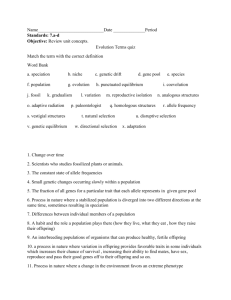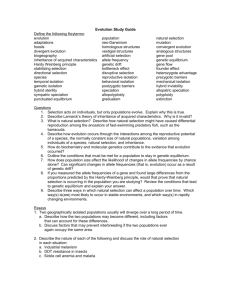Chapter-17
advertisement
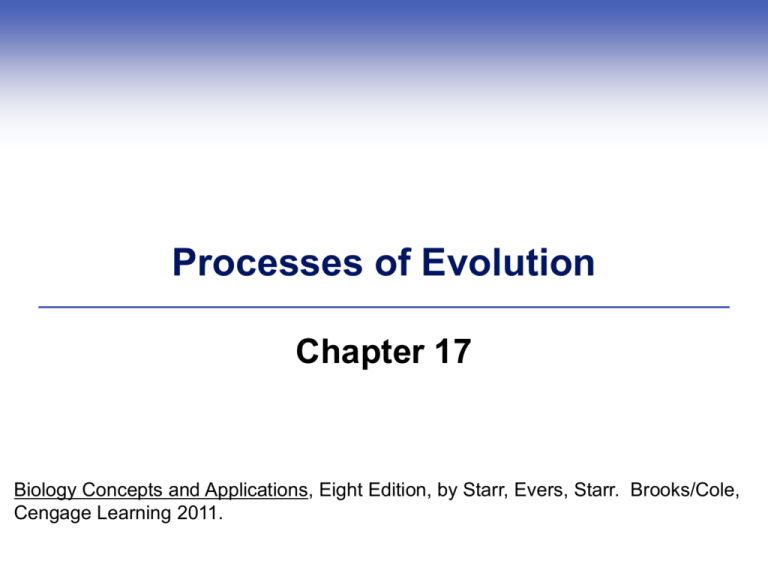
Processes of Evolution Chapter 17 Biology Concepts and Applications, Eight Edition, by Starr, Evers, Starr. Brooks/Cole, Cengage Learning 2011. Rise of the Super Rat Rat (Rattus) • • • • Most notorious of mammalian pests City = 1 rat for every 10 people Reproduce fast Cost us about $19 billion per year due to damages (infection or property) • Warfarin – rodenticide of choice • Blood thinner internal bleeding and increase blood loss from cuts or scrapes • 10% of rats in urban area in the US are resistant to warfarin • Gene mutation (enzyme insensitive to inhibitory action of warfarin) Rise of the Super Rat Rat (Rattus) • Mutation = Evolution by natural selection • Warfarin = pressure on rat population • Pressure lead to population changes • Survivors (or mutants) survived while normal rats died • Survivors passed warfarin-resistance alleles to their offspring • Selective pressure can and do change • Alternating pressures in the key to success!! Rise of the Super Rats 17.2 Populations Evolve Population • Individuals of the same species in the same area • Generally the same number and kinds of genes for the same traits Gene pool • All the alleles of the genes of a population • Pool of genetic resources Variation in Alleles Individuals who inherit different combinations of alleles vary in details of one or more traits • Polymorphism: Several alleles in a population Mutations are the original source of new alleles • Lethal mutations result in altered phenotype and death • Neutral mutations neither help nor hurt Phenotypic Variation in Populations Microevolution Allele frequency • Abundance of a particular allele among members of a population • Change in an allele’s frequency in a population is the same thing as change in a line of descent Microevolution (evolution) = Changes in allele frequencies of a population • • • • Mutation Natural selection Genetic drift Gene flow When Is A Population Not Evolving? Genetic equilibrium • A state in which a population is not evolving • Never occurs in nature Deviations from theoretical genetic equilibrium are used to study how a population is evolving 17.3 Hardy-Weinberg Equilibrium Equation Independently applied the rules of probability to sexually reproducing population Discovered that Gene Pools can remain stable only when 5 conditions are met 1. Mutations do not occur 2. The population is infinitely large 3. The population is isolated from all other populations of the species 4. Mating is random 5. All individuals survive and produce the same number of offspring 17.3 Hardy-Weinberg Equilibrium Equation If frequency of alleles in a population changes, the population is evolving p + q = 1.0 p2 + 2pq + q2 = 1.0 p and q = frequencies of alleles A and a 2 pq = carrier frequency ***Page 260-261 in TEXT*** Is This Population Evolving? NO!! 490 AA butterflies dark-blue wings 490 AA butterflies dark-blue wings 490 AA butterflies dark-blue wings 420 Aa butterflies medium-blue wings 420 Aa butterflies medium-blue wings 420 Aa butterflies medium-blue wings 90 aa butterflies white wings 90 aa butterflies white wings 90 aa butterflies white wings Starting Population Next Generation Next Generation Fig. 17.3, p.268 Natural Selection Natural selection • Environmental pressure result in the differential survival and reproduction among individuals of a population that vary in the details of shared, heritable traits(alleles) Allele frequencies • Maintained by stabilizing selection • Shifted by directional or disruptive selection • Directional selection mode of natural selection in which phenotypes at one end of a range of variation are favored 17.5 Modes of Natural Selection Directional Selection Shifts range of variation in traits in one direction • Individuals at one end of the range are favored; those at the other end are not Examples: • Peppered moth, pocket mice (predation) • Antibiotic resistance Directional Selection Peppered Moth Pocket Mice 17.6 Selection For or Against Extreme Phenotypes Stabilizing Selection • Mode of natural selection in which intermediate forms of a trait are favored over extremes • Favors intermediate forms Disruptive selection • Mode of natural selection that favors forms of a trait at the extremes of a range of variation • Favors forms at extremes of the range Stabilizing and Disruptive Selection Stabilizing Selection: Birth Weight Disruptive Selection: Finch Bill Size Soft seed eaters Hard seed eaters Intermediate-sized bills can not open soft or hard seeds as efficiently. Decreased survival! 17.7 Maintaining Variation 1. Sexual Selection (sexual dimorphism) • A female or a male acts as an agent of selection on its own species • Some individuals out reproduce others of a population because they are better at securing mates • Leads to trait forms that favor reproductive success 2. Balanced polymorphism • Nonidentical alleles for a trait are maintained at relatively high frequencies in a population • Result of natural selection against homozygous Sexual Selection Balanced Polymorphism Malaria Sickle-cell allele Increase survival from malaria 17.8 Genetic Drift Genetic drift • Random change in a population’s allele frequencies over time, due to chance • Can lead to loss of genetic diversity Fixed • Refer to an allele for which all members of a population are homozygous • Frequency of fixed alleles will not change unless mutation or another process introduces a different allele Effect of Population Size on Genetic Drift Frequency of b+ allele 100% 50% N = 10 0 0 4 8 12 16 20 generations N = number of breeding individuals per generation a The size of these populations of beetles was maintained at 10 breeding individuals. Allele b+ was lost in one population (one graph line ends at 0). Drift was greatest in sets of 10 beetles and least in the sets of 100. Fig. 17.14a, p.276 Frequency of b+ allele 100% 50% N = 100 0 0 4 8 12 16 20 generations N = number of breeding individuals per generation b The size of these populations was maintained at 100 individuals. Drift in these populations was less than the small populations in (a). Fig. 17.14b, p.276 17.8 Genetic Drift Most pronounced in small or inbred populations • Bottleneck: • Drastic reduction in population so severe that is reduces genetic diversity • Can result in a few individuals rebuilding a population or starting a new one • Example elephant seals (hunted until 20 remained, hunted banned and now 170,000 exist) • Genetic drift after bottleneck fixed all the alleles in the population 17.8 Genetic Drift Most pronounced in small or inbred populations • Founder effect: • change in allele frequencies that occurs when a small number of individuals establish a new population • Occurs if the small group is not representative of the original population in terms of allele frequencies • New population is not representative of the old • Genetic diversity of reduced Founder Effect 17.9 Gene Flow Gene flow • Movement of alleles into or out of a population by immigration or emigration • Helps keep populations of same species similar Counters processes that cause populations to diverge (mutation, natural selection, genetic drift) Gene Flow Between Oak Populations Key Concepts: MICROEVOLUTION Populations evolve Individuals of a population differ in which alleles they inherit, and thus in phenotypes Over generations, any allele may increase or decrease in frequency in a population Such shifts occur by the microevolutionary processes of mutation, natural selection, genetic drift, and gene flow 17.10 Reproductive Isolation Individuals of a sexually reproducing species can produce fertile offspring, but are reproductively isolated • Sexually reproducing species attain and maintain their separate identities • Prevent interbreeding and reinforces differences between diverging populations Reproductive isolating mechanisms evolve when gene flow between populations stops 17.10 Reproductive Isolation Reproductive isolation is always part of speciation • Speciation one of several processes by which new species arise Divergences may lead to new species Reproductive Isolating Mechanisms Prezygotic isolating mechanisms – pollination or mating cannot occur or zygotes can not form • • • • • Temporal isolation Mechanical isolation Behavioral isolation Ecological isolation Gamete incompatibility Postzygotic isolating mechanisms – if hybrids form but are infertile • Hybrid sterility or in-viability Reproductive Isolating Mechanisms Different species! Prezygotic isolating mechanisms Temporal isolation: Individuals of different species reproduce at different times. Mechanical isolation: Individuals cannot mate or pollinate because of physical incompatibilities. Behavioral isolation: Individuals of different species ignore or do not get the required cues for sex. Ex. Different vocalizations and movements from the male bird. Ecological isolation: Individuals of different species live in different places and never do meet up. They interbreed anyway. Gamete incompatibility: Reproductive cells meet up, but no fertilization occurs. Zygotes form, but . . . Postzygotic isolating mechanisms Hybrid inviability: Hybrid embryos may die early, OR new individuals die before they can reproduce due to reduced fitness, health, and life expectancy. Ex. Ligers and tigons Hybrid sterility: Hybrid individuals or their offspring do not make functional gametes. Ex. Mule (female horse and male donkey) OR offspring have lower and lower fitness with each successive generation Mechanical Isolation Black sage honeybees White sage larger bees and hawkmoths bc honeybees are too small Behavioral Isolation Species-specific courtship prior to sex. 17.11 Allopatric Speciation Allopatric speciation One way new species form • Speciation pattern in which a physical barrier that separates members of a population ends gene flow between them. A geographic barrier stops gene flow between two or more populations of a species • Example: The Great Wall of China and insectpollinated plants, isolated continents or archipelagos Genetic divergence and reproductive isolation give rise to new species An Isolated Archipelago 17.12 Other Speciation Models Sympatric speciation (sym – same) • Pattern in which speciation occurs in the absence of a physical barrier • Populations in physical contact diverge into separate species • Polyploid species of many plants originated by chromosome doublings and hybridizations Sympatric Speciation: Wheat Triticum Unknown monococcum species of (einkorn) wild wheat a By 11,000 years ago, humans were cultivating wild wheats. Einkorn has a diploid chromosome number of 14 (two sets of 7). It probably hybridized with another wild wheat species having the same number of chromosomes. Hybridization was followed by spontaneous chromosome doubling. T. turgidum (wild emmer) b About 8,000 years ago, the alloploid wild emmer originated from an AB hybrid wheat plant in which the chromosome number doubled. Wild emmer is tetraploid, or AABB; it has two sets of 14 chromosomes. There is recently renewed culinary interest in emmer, also called farro. T. tauschii (a wild relative) T. aestivum (one of the common bread wheats) c AABB emmer probably hybridized with T. tauschii, a wild relative of wheat. Its diploid chromosome number is 14 (two sets of 7 DD). Common bread wheats have a chromosome number of 42 (six sets of 7 AABBDD). Fig. 17.23, p.282 Other Speciation Models Parapatric speciation • Different selection pressures lead to divergences within a single population • Occur when one population extends across a broad region encompassing diverse habitats • Different habitats exert distinct selection pressures on parts of the population Divergence speciation • Hybrids form in the contact zone between habitats • Hybrids are less fit than individuals outside of the zone Parapatric Speciation Walking worms can interbreed. Hybrids are sterile. T. barretti hybrid zone T. anophthalmus Fig. 17.25c, p.283 Different Speciation Models Key Concepts: HOW SPECIES ARISE Sexually reproducing species consist of one or more populations of individuals that interbreed successfully under natural conditions, produce fertile offspring, and are reproductively isolated from other species The origin of new species varies in details and duration Key Concepts: HOW SPECIES ARISE (cont.) Typically, speciation starts after gene flow ends between parts of a population Microevolutionary events occur independently, lead to genetic divergence of subpopulations Such divergences are reinforced as reproductive isolation mechanisms evolve 17.13 Macroevolution Review: Microevolution is a change in allele frequencies within a single species or population Macroevolution Large-scale patterns of evolution • One species giving rise to others • Dinosaur Bird • Fish 4 leg tetrapod animals • Seed plant Flowering plant • Origin of major groups • Major extinctions Patterns of Macroevolution 1. Preadaptation OR Exaptation • A lineage may use a structure for a different purpose than its ancestor did • Evolutionary novelty • ex. Feathers Birds (flight) vs. Dinosaurs (insulation) 2. Stasis • Lineage persists with little or no change over evolutionary time 3. Extinct • Refers to species that have been permanently lost • Fossils indicate at least 20 mass extinctions, 5 being catastrophic events Patterns of Macroevolution 4. Adaptive radiation • Burst of genetic divergences from a lineage new species • Ex. After individuals colonize a new environment that has a variety of different habitats with few or no competitors honeybee creepers of Hawaiian • Cause: 1) Key innovation 2) geologic or climatic events eliminate some species from a habitat Key innovation • Modification or new trait that allows an organism to exploit its environment in new, more efficient way • Ex. Evolution of the lung Patterns of Macroevolution 5. Coevolution • The joint evolution of two closely interacting species • Each species is a selective agent for traits of the other • Each adapt to changes in the other • Species may become interdependent Key Concepts: PATTERNS IN LIFE’S HISTORY Genetic change above the population level is called macroevolution Recurring patterns of macroevolution include preadaptation, adaptive radiation, coevolution, and extinction Adaptation to What? Evolutionary adaptation • Heritable traits that improve an individual’s chance of surviving and reproducing (under conditions that prevailed when genes evolved) Adaptation to Elevation Key Concepts: ADAPTATION AND THE ENVIRONMENT An evolutionary adaptation is a heritable aspect of form, function, behavior, or development that increases an individual’s capacity to survive and reproduce in a particular environment 17.14 Phylogeny Phylogeny Evolutionary history of a species or groups of species Evolutionary tree • Type of diagram that summaries evolutionary relationships among a group of species Cladistics • Method of determining evolutionary relationships by grouping species into clades based on shared characters • Clade: a species or groups of species that share a set of characteristics • Character: quantifiable, heritable characteristic/trait 17.14 Phylogeny Cladogram • Evolutionary tree that shows a network of evolutionary relationships among clades Monophyletic group • Each clade is a monophyletic group that comprises an ancestor and all of it descendants Sister groups • Two lineages that emerge from a node on a cladogram Constructing a Cladogram Fig. 16.27d, p.260 Animation: Adaptation to what? Animation: Albatross courtship Animation: Allopatric speciation on an archipelago Animation: Change in moth population Animation: Directional selection Animation: Disruptive selection Animation: Disruptive selection among African finches Animation: Distribution of sickle-cell trait Animation: How to find out if a population is evolving Animation: Models of speciation Animation: Reproductive isolating mechanisms Animation: Simulation of genetic drift Animation: Stabilizing selection Animation: Sympatric speciation in wheat Animation: Temporal isolation among cicadas
